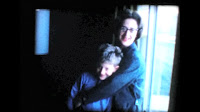 My husband has taken on the project of transferring old home movies into digital video. We’ve had
My husband has taken on the project of transferring old home movies into digital video. We’ve had some good laughs, and refreshed memories, over the old films. We’ve also taken away a few tips for those who seek to preserve today’s occasions for future memories.
It doesn’t matter whether you’re using a digital camera, smartphone, or other type of technology, as these apply to style and content:
- Forget the food. There may be a sentimental reason to feature a shot of a birthday cake or holiday spread, but don’t bother featuring food in your movie. We’d much rather see grandma’s smile or Aunt Sylvia’s wave than what was served at the wedding.
- Move in for the close-up. Long shots are good for establishing a scene, but then move in. The relatives in your movies won’t be around forever, or won’t look so fresh and young after several decades, so treat your audience with big close-ups that reveal how sis and baby brother looked at that moment. And, crucially important, most small cameras can’t capture good audio from a distance. If you want to be able to understand what they’re saying, it’s got to be shot from seven feet or closer.
- It’s a “moving” picture, so don’t ask people to stand still. Let’s see how mom danced, the tangle of little kids playing soccer, or the family rocking in chairs on the porch. Don’t stage a group shot, as you would with a still camera.
- Slow down. Camera movement is great as you pan around the room or field, but slow and steady will help your viewing audience keep their lunch. Moving too fast or herky-jerky while filming can have a nauseating effect on viewers.
- Be sneaky when necessary. Some relatives hide when the camera comes out. Back in the day, it was hard to avoid knowing when the camera was on, what with bright movie lights and loud camera mechanisms. Now it’s easier to capture the parents before they wave you off.
- Record the fun. What we’ve found is the wish to see relatives look natural and at ease with one another. But, having said that, there’s nothing like the unguarded joy of siblings or friends having a good time. It might just be a hot day with a garden hose, or a sneak snowball attack on your sister. Make the camera inconspicuous (point 5 above), stake out a good spot to start, and don’t hesitate to move around to get the best angles.
- Record and archive in highest quality possible. For the first time in the history of motion imagery, many of us have cameras in our pockets that could, in the right hands, shoot pieces of a Hollywood movie. The first rule is to shoot at the highest resolution and quality available on your device. And learn how to transfer the raw footage to your computer for long-term storage. Don’t count on saving the clips you loaded up to social media, because that footage is usually highly compressed in the process, with great loss of quality. Yes, you’ll probably want to learn how to do some basic editing in iMovie or Premiere, throwing out the junk, and always saving at the highest quality once you’re done. You will end up investing in external storage drives, which are relatively cheap and plentiful, but archiving carefully is key to future generations being able to enjoy what was going on way back…now.
 It’s great to look back through photo albums, in hard copy or digital, but in 30 years or so there will be nothing like seeing Mom making pasta or your brother going to the prom with his future wife.
It’s great to look back through photo albums, in hard copy or digital, but in 30 years or so there will be nothing like seeing Mom making pasta or your brother going to the prom with his future wife. 
No comments:
Post a Comment